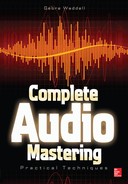CHAPTER 10
Fades, Sequencing, and Spacing
The way you get from one song to another on an album is important to the listening experience. You feel it. In mastering, you should always work to achieve the best effect as you transition between songs. This transition is made up of not only the fades and spacing but also the sequence of the songs.
Spacing Between Songs
The spacing between songs is important to the listening experience and must be set in a way that works artistically. The way you accomplish this varies depending on the digital audio workstation (DAW) you are using.
With some DAWs, spacing between songs is very easy to set and audition. Samplitude and Sequoia are two DAWs that make the task easy. Some of the least powerful mastering DAWs require the engineer to master a recording, bounce it to a wave, and then use another program to audition the spacing. Being able to quickly audition and adjust spacing is essential for creating a musical and natural flow.
It is usually best to audition the space between recordings by listening to playback from a point that is significantly before the space. This helps to gain perspective about how the listener may experience it. Perfect spacing is a matter of timing and musical intuition.
Most DAWs feature a mode where the play cursor stays at its current position when playback is stopped. Otherwise, play cursors normally return to the starting point when the user presses “Stop.” This mode can be useful for creating natural-sounding spaces between tracks. Assigning a keyboard shortcut to this mode adds convenience.
There exists a technique where a room-tone recording may be used in the spaces between recordings, where otherwise the listener would hear perfect digital silence. This creates continuity between songs. Room tone is extracted from the silence at the head or tail of a recording or by requesting a clip from the mixing engineer if no head or tail provides long enough silence.
Performing Fades/Cross-Fades
Fades and cross-fades are also accomplished in ways that work artistically with the recording at hand and are very DAW-specific. It is important to explore all the fading options of the DAW used for mastering.
Cross-fades are used to fade between one recording and another and are often used to make seamless transitions between songs. When this is done, the CD pause time is set to zero, and the track marker between the songs is set wherever desired.
Fades and cross-fades are usually done nondestructively, that is, in a way that does not alter the original source.
Fades During Mixing Stage
Fades during the mixing stage are performed in a DAW with automation, fade curves, or a master fader. Fading during the mixing stage provides a big benefit—it allows the creativity of the mixing session to be put into the fades. Of course, this must be done carefully. Today, performing fades during mixing is most common.
Fades During Mastering Stage
There are a few different ways to request fades during mastering. First, they can be discussed and performed during attended sessions. For unattended sessions, fade times and lengths can be provided to the mastering engineer. Sometimes both faded and unfaded recordings are sent for mastering, allowing the mastering engineer to work from a reference fade. Also, it can always be left up to the mastering engineer to perform fades at his or her own discretion.
Performing Fades During Mastering Has Its Own Set of Benefits
Most dedicated mastering DAWs have more fade types and fade customization than typical mixing DAWs. Mastering fades are done in sequence after the limiting and compression so that they are not affected by those processes, as are fades performed during mixing. Performing fades during mastering is the very best choice when the transitioning and sequencing of the album will be highly creative.
Sequencing an Album
Today, the sequence of songs on an album is usually decided before mastering. However, mastering engineers usually offer suggestions if the album sequence seems problematic. Rarely, the mastering engineer will be called on to set the sequence. When this is the case, the songs are usually set according to the mastering engineer’s musical intuition.
Noise Reduction
Noise-reduction processing is considered to be corrective processing and is usually performed at the beginning of the chain.
Denoise First
Noise reduction and other corrective processing are usually done very early in the chain. Usually, they are preceded only by DC-offset removal, if needed.
Noise at Beginnings and Endings
Noise is usually most audible at the beginning or ending of a recording. It is usually best to process only the sections where it is audible. Often this processing will be performed destructively.
Learn Feature
Many noise-reduction processors are equipped with a learn feature. A playback loop is set on a section where only the noise can be heard. Then the processor is set to “learn.” Afterwards, the noise-reduction processing is applied with the noise profile it learned. This processing varies depending on the software being used, so reading the user manual is a must.
Noise/Hiss/Clicks/Pops
Different noise-reduction algorithms specialize in various types of noise problems. The correct processing should be used for the problem at hand.
Spectral Editing
Spectral editing processors allow for noises, clicks, and pops to be removed using a spectral display. At its core, this process is an automated equalizer. Samplitude and Sequoia have spectral editing built in, allowing for surgical reduction of clicks and pops in an unnoticeable way.
Careful Application
Noise-reduction processing can easily degrade a recording, so it is very important to apply it carefully.
